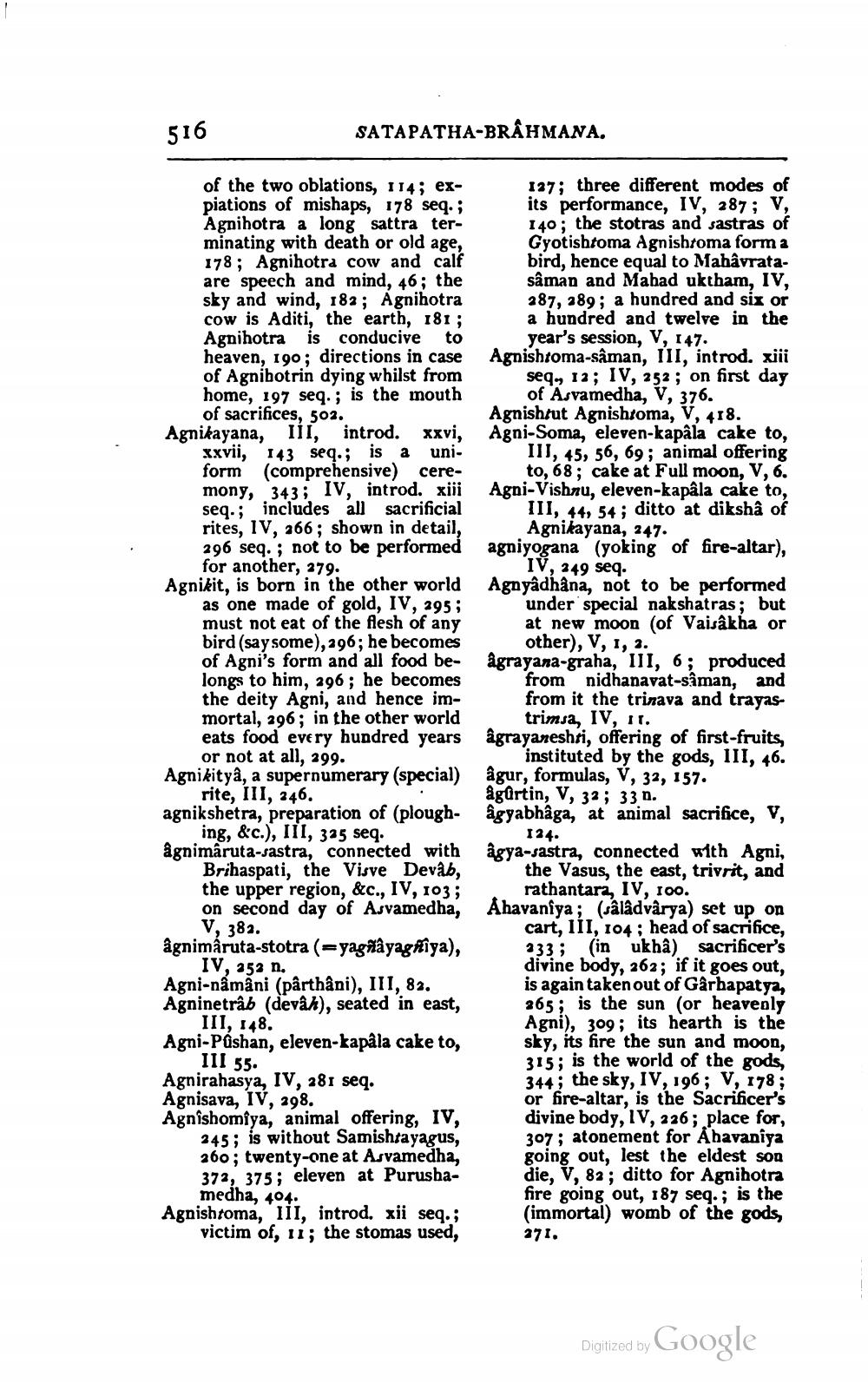________________
516
SATAPATHA-BRÂHMANA.
of the two oblations, 114; expiations of mishaps, 178 seq. ; Agnihotra a long sattra terminating with death or old age, 178; Agnihotra cow and calf are speech and mind, 46; the sky and wind, 182; Agnihotra cow is Aditi, the earth, 181; Agnihotra is conducive to heaven, 190; directions in case of Agnibotrin dying whilst from home, 197 seq. ; is the mouth
of sacrifices, 502. Agnikayana, III, introd. xxvi,
xxvii, 143 seq.; is a uniform (comprehensive) ceremony, 343; IV, introd. xiji seq.; includes all sacrificial rites, IV, 266; shown in detail, 296 seq. ; not to be performed
for another, 279. Agnikit, is born in the other world
as one made of gold, IV, 295; must not eat of the flesh of any bird (say some), 296; he becomes of Agni's form and all food be- longs to him, 296; he becomes the deity Agni, and hence immortal, 296; in the other world eats food every hundred years
or not at all, 299. Agnikitya, a supernumerary (special)
rite, III, 346. agnikshetra, preparation of (plough-
ing, &c.), III, 325 seq. ågnimâruta-sastra, connected with
Brihaspati, the Visve Devab, the upper region, &c., IV, 103; on second day of Asvamedha,
127; three different modes of its performance, IV, 287; V, 140; the stotras and sastras of Gyotishtoma Agnishtoma forma bird, hence equal to Mahâvratasâman and Mahad uktham, IV, 287, 289; a hundred and six or a hundred and twelve in the
year's session, V, 147. Agnishtoma-saman, III, introd. xiii
seq., 12; IV, 252; on first day
of Asvamedha, V, 376. Agnishtut Agnishtoma, V, 418. Agni-Soma, eleven-kapala cake to,
III, 45, 56, 69; animal offering
to, 68; cake at Full moon, V, 6. Agni-Vishnu, eleven-kapâla cake to,
III, 44, 54; ditto at diksha of
Agnikayana, 247. agniyogana (yoking of fire-altar),
IV, 249 seq. Agnyâdhâna, not to be performed
under special nakshatras; but at new moon (of Vaisakha or
other), V, 1, 3. &grayana-graha, III, 6; produced
from nidhanavat-sîman, and from it the trinava and trayas
trimsa, IV, 11. âgrayaneshti, offering of first-fruits,
instituted by the gods, III, 46. âgur, formulas, V, 32, 157. ågürtin, V, 32; 33 n. ágyabhaga, at animal sacrifice, V,
124. agya-sastra, connected with Agni,
the Vasus, the east, trivrit, and
rathantara, IV, 100. Ahavaniya; (saladvarya) set up on
cart, 111, 104; head of sacrifice, 333; (in ukhâ) sacrificer's divine body, 262; if it goes out, is again taken out of Garbapatya, 265; is the sun (or heavenly Agni), 309; its hearth is the sky, its fire the sun and moon, 315; is the world of the gods, 344; the sky, IV, 196; V, 178; or fire-altar, is the Sacrificer's divine body, IV, 226; place for, 307; atonement for Åhavaniya going out, lest the eldest son die, V, 82; ditto for Agnihotra fire going out, 187 seq.; is the (immortal) womb of the gods, 271.
V, 382.
âgnimâruta-stotra (=yagiâyaghiya),
IV, 252 n. Agni-nâmâni (pârthâni), III, 82, Agninetrab (devah), seated in east,
III, 148. Agni-Pashan, eleven-kapâla cake to,
III 55. Agnirahasya, IV, 281 seq. Agnisava, IV, 298. Agnishomiya, animal offering, IV,
245; is without Samishrayagus, 260; twenty-one at Asvamedha, 372, 375; eleven at Purusha
medha, 404. Agnishtoma, III, introd. xii seq.;
victim of, 11 ; the stomas used,
Digitized by Google




